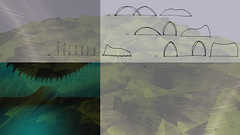Monday, November 10, 2008
Saturday, October 18, 2008
Tuesday, October 7, 2008
TrafficRoomSim
"alluring, repelling"
A biofuel station accepts people and their vehicles from the surrounding streets and it is important to explore their interaction to develop an architectural outcome that allows them to interact safely.
This sim aims to create an environment that is abstracted from the geometry of the site but not representative of it. In this way it becomes a neutral room in which people and their vehicles occupy space together.
Do they share space? What effects do boundaries have? And what happens when we suggest a boundary rather than enforce it?
ClothReactionSim
"voluptuous"
There was a particular focus on simulating cloth in order to form a premise for testing a morphing building. One which leans over for morning sun, then bows down to the midday sun, and then rolls onto its side for afternoon sun. An adaptable architecture that forms and reforms itself within the environment.
This sim aims to experiment with the capability of form making with cloth through its interaction with other objects.
Basic volumes are thrown and pushed into, dropped and rolled onto, different properties to see their effect and reaction. The reaction especially had been observed to return a force to the object, in the form of bouncing.
ClothTearSim
"that rips, and under stress, tears"
Following on from the experiment above, this seeks to set up a method to test the limitations, boundaries and extents to which cloth can strecth before it fails. The process here is to actually force a failure in a controlled environment, and by doing so discover its limits.
This sim aims to experiment with the breaking point of cloth material.
This is done by specifying a maximum size factor, such as 150% of original length, beyond which UT3 will simulate its tearing due to stress. Although this material failure is shown as tearing, it is expected that cloth failure in real life will come in the form of excessive stretching such that it cannot return to its initial form.
With this in mind, the next step will be to identify real stretch factors as specified by manufacturers of cloth products and test them in the engine.
Tuesday, September 23, 2008
Sunday, August 31, 2008
Draft:1
Photosynthesis
The process to convert CO2 to O2 is a naturally occurring process that leaves carbon in the form of biomass. Algae are the fastest growing plant known on Earth and have the potential to double its biomass in a single day. This potential to convert such large amounts of CO2 is important in maximising the usefulness of a relatively small site. This proposal exploits the advantages of this by providing the external shell of a building that is transparent and hollow in order to become like a bioreactor.
Selection of program
The decision to combine the concept of an air treatment plant with a biofuel station comes from the contextual issue of the site being a point of extraction of CO2 gases from the ED tunnel. It opens up the opportunity to be used by more people than simply staff and personnel, which is important to ensure its utilisation.
Integration into current infrastructure
This is important because it ensures that the scheme is both accepted and utilised with ease in our current society. There are a growing number of vehicle manufacturers moving to diesel engines. There is a cyclical process involved here with CO2 being produced from fuel burning in cars and fuel being produced from CO2 being converted through the bioreactor.
Supply and Demand
The production of biofuel depends heavily on hours of sunlight and amount of CO2 supplied. If the number of cars using the tunnel should reduce, so too does the potential to produce fuel for those cars. In turn, there is a direct relationship between the amount of fuel able to be produced and the number of cars on the roads.
Maximising surface area towards sun
Obviously by increasing the area that is exposed to direct sunlight, we increase our potential to convert CO2 to biomass + O2. The extent to which this is prioritised should be weighted closely with the amount of energy invested into achieving such goals.
Module framework
There is a conscious effort to maintain a regular module or grid with construction, since it was stated in previous exploration that such a system would set up the use of the project as an example for multiple scales. This is important as a marketing strategy that can open opportunity for similar systems to be used in residential projects. C.f. Dam and water tank analogy.
Storage of different stages in the CO2->biofuel process
The level drop on site is being utilised to store different items that are part of the CO2 to biofuel process. These include concentrated CO2, water, algae water, harvested oil, cultured oil, and biodiesel.
Size of production
Further research must be done to evaluate the size needed to address the large volumes of CO2 that are extracted from the tunnel. It is expected that the proposed scheme can only convert a small percentage of such volume. Its intention is to convert as much as it can within the limitations of the site. This raises questions about how do we deal with such problems in cities where there is competition for land.
Saturday, August 16, 2008
Further research:
http://au.youtube.com/watch?v=EnOSnJJSP5c
The forms that these farms take open opportunities for use with architectural elements. Transparency, opacity, structure, colour.
